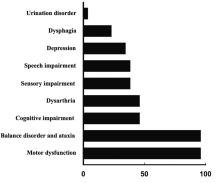| 1 |
赵继宗. 神经外科学[M]. 4版. 北京: 人民卫生出版社, 2019: 264-270.
|
| 2 |
《中国中枢神经系统胶质瘤诊断和治疗指南》编写组. 中国中枢神经系统胶质瘤诊断与治疗指南(2015)[J]. 中华医学杂志,2016, 96(7): 485-509.
|
| 3 |
CIRILLO S, CAULO M, PIERI V,et al. Role of functional imaging techniques to assess motor and language cortical plasticity in glioma patients: a systematic review[J].Neural Plast, 2019, 2019: 4056436.
|
| 4 |
SHAHPAR S, MHATRE P V, HUANG M E. Update on brain tumors: new developments in neuro-oncologic diagnosis and treatment, and impact on rehabilitation strategies[J]. PM&R, 2016, 8(7): 678-689.
|
| 5 |
THAKKAR P, GREENWALD B, PATEL P. Rehabilitation of adult patients with primary brain tumors:a narrative review[J].Brain Sci,2020,10(8):492.
|
| 6 |
VARGO M. Brain tumor rehabilitation[J]. Am J Phys Med Rehabilitation, 2011, 90(5): S50-S62.
|
| 7 |
张玉梅, 宋鲁平. 康复评定常用量表[M]. 北京: 科学技术文献出版社, 2018: 25-423.
|
| 8 |
王 孜, 谢 坚, 江 涛, 等. 幕上脑胶质瘤100例术后并发症临床研究[J].医学研究杂志,2010,39(1):80-83.
|
| 9 |
梁 伦, 余永佳, 黄 玮. 颅内肿瘤切除术后术区水肿扩大2例[J]. 中国临床神经外科杂志, 2020, 25(9): 653-654.
|
| 10 |
武宏杰, 李 静, 徐东晓, 等. 32例脑膜瘤患者术后死亡原因分析[J]. 肿瘤学杂志, 2018, 24(4): 393-396.
|
| 11 |
楚燕飞, 王 辉, 张 旋, 等. 颅内肿瘤术后出血临床分析[J]. 中国微侵袭神经外科杂志, 2019, 24(12): 561-562.
|
| 12 |
张科. 急性缺血性脑卒中患者下肢深静脉血栓形成的危险因素分析[D]. 泸州: 西南医科大学, 2020.
|
| 13 |
张丽敏, 郭雨童, 曹 磊, 等. 脑肿瘤患者围术期凝血-纤溶相关指标及血小板水平变化[J]. 检验医学与临床, 2017, 14(2): 158-160.
|
| 14 |
余永佳, 梁 伦, 黄 玮, 等. 颅内肿瘤术后凝血功能障碍的危险因素分析[J]. 中国临床神经外科杂志, 2020, 25(12): 828-830.
|
| 15 |
马 军, 秦叔逵, 吴一龙, 等. 肿瘤相关静脉血栓栓塞症预防与治疗指南(2019版)[J]. 中国肿瘤临床, 2019, 46(13): 653-660.
|
| 16 |
POLITSKY J M. Brain tumor-related epilepsy: a current review of the etiologic basis and diagnostic and treatment approaches[J]. Curr Neurol Neurosci Rep, 2017, 17(9): 70.
|
| 17 |
谢伟星, 龚文劲, 张高炼, 等. 脑肿瘤患者预防性使用抗癫痫药物疗效及不良反应的meta分析[J]. 广西医科大学学报, 2014, 31(3): 448-451.
|
| 18 |
中华医学会.临床诊疗指南:神经外科学分册[M].北京:人民卫生出版社,2013: 35-37.
|
| 19 |
KOS N, KOS B, BENEDICIC M. Early medical rehabilitation after neurosurgical treatment of malignant brain tumours in Slovenia[J].Radiol Oncol, 2016,50(2): 139-144.
|
| 20 |
MCALPINE H, SEJKA M, DRUMMOND K J. Brain tumour patients’ use of social media for disease management: Current practices and implications for the future[J]. Patient Educ Couns, 2021, 104(2): 395-402.
|
| 21 |
DÉNES Z, TARJÁNYI S, NAGY H. Rehabilitation possibilities and results after neurosurgical intervention of brain tumors[J].Ideggyogyaszati Szemle,2019,72(3/4):123-129.
|
| 22 |
NAKAJIMA R, KINOSHITA M, OKITA H, et al. Glioma surgery under awake condition can lead to good independence and functional outcome excluding deep sensation and visuospatial cognition[J]. Neurooncol Pract, 2019, 6(5): 354-363.
|
| 23 |
COOMANS M B, LINDEN S DVAN DER, GEHRING K, et al. Treatment of cognitive deficits in brain tumour patients: current status and future directions[J]. Curr Opin Oncol, 2019, 31(6): 540-547.
|
| 24 |
NGJ C H,SEE A A Q,ANG T Y,et al.Effects of surgery on neurocognitive function in patients with glima:a meta-analysis of immediate post-operative and long-term follow-up neurocognitive outcomes[J]. Neuro Oncol, 2019,141(1): 167-182.
|
| 25 |
HENDRIKS E J, HABETS E J J, TAPHOORN M J B,et al. Linking late cognitive outcome with glioma surgery location using resection cavity maps[J]. Hum Brain Mapp, 2018, 39(5): 2064-2074.
|
| 26 |
HABETS E J J, HENDRIKS E J, TAPHOORN M J B,et al. Association between tumor location and neurocognitive functioning using tumor localization maps[J]. J Neurooncol, 2019, 144(3): 573-582.
|
| 27 |
NG J C H, SEE A A Q, ANG T Y, et al. Effects of surgery on neurocognitive function in patients with glioma: a meta-analysis of immediate post-operative and long-term follow-up neurocognitive outcomes[J]. J Neuro Oncol, 2019, 141(1): 167-182.
|
| 28 |
HOFFMANN K, KAMP M, STEIGER H J, et al. Correlation of psychooncological distress- screening and quality of life assessment in neurosurgical patients[J]. Oncotarget, 2017, 8(67): 111396-111404.
|
| 29 |
RAPP M, SCHIPMANN S, HOFFMANN K, et al. Impact of distress screening algorithm for psycho-oncological needs in neurosurgical patients[J]. Oncotarget, 2018, 9(60): 31650-31663.
|
| 30 |
BRAT D J, SCHEITHAUER B W, FULLER G N, et al. Newly codified glial neoplasms of the 2007 WHO classification of tumours of the central nervous system: angiocentric glioma, pilomyxoid astrocytoma and pituicytoma[J]. Brain Pathol, 2007, 17(3): 319-324.
|
| 31 |
FU J B, PARSONS H A, SHIN K Y, et al. Comparison of functional outcomes in low- and high-grade astrocytoma rehabilitation inpatients[J]. Am J Phys Med Rehabil, 2010, 89(3): 205-212.
|
| 32 |
DE BIASE G, GARCIA D P, BOHNEN A, et al. Perioperative management of patients with glioblastoma[J]. Neurosurg Clin N Am, 2021, 32(1): 1-8.
|
 )
)


